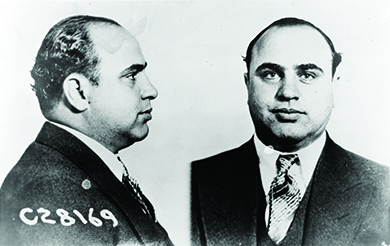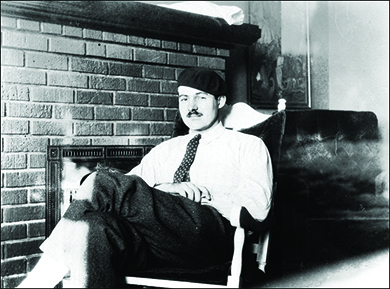| << Chapter < Page | Chapter >> Page > |
Prohibition also revealed deep political divisions in the nation. The Democratic Party found itself deeply divided between urban, northern “wets” who hated the idea of abstinence, and rural, southern “dries” who favored the amendment. This divided the party and opened the door for the Republican Party to gain ascendancy in the 1920s. All politicians, including Woodrow Wilson, Herbert Hoover, Robert La Follette, and Franklin D. Roosevelt, equivocated in their support for the law. Publicly, they catered to the Anti-Saloon League; however, they failed to provide funding for enforcement.
Prohibition sparked a rise in organized crime. “Scarface” Al Capone ( [link] ) ran an extensive bootlegging and criminal operation known as the Chicago Outfit or Chicago mafia. By 1927, Capone’s organization included a number of illegal activities including bootlegging, prostitution, gambling, loan sharking, and even murder. His operation was earning him more than $100 million annually, and many local police were on his payroll. Although he did not have a monopoly on crime, his organizational structure was better than many other criminals of his era. His liquor trafficking business and his Chicago soup kitchens during the Great Depression led some Americans to liken Capone to a modern-day Robin Hood. Still, Capone was eventually imprisoned for eleven years for tax evasion, including a stint in California’s notorious Alcatraz prison.

As the country struggled with the effects and side-effects of prohibition, many young intellectuals endeavored to come to grips with a lingering sense of disillusionment. World War I, fundamentalism, and the Red Scare—a pervasive American fear of Communist infiltrators prompted by the success of the Bolshevik Revolution—all left their mark on these intellectuals. Known as the Lost Generation , writers like F. Scott Fitzgerald, Ernest Hemingway, Sinclair Lewis, Edith Wharton, and John Dos Passos expressed their hopelessness and despair by skewering the middle class in their work. They felt alienated from society, so they tried to escape (some literally) to criticize it. Many lived an expatriate life in Paris for the decade, although others went to Rome or Berlin.
The Lost Generation writer that best exemplifies the mood of the 1920s was F. Scott Fitzgerald, now considered one of the most influential writers of the twentieth century. His debut novel, This Side of Paradise , describes a generation of youth “grown up to find all gods dead, all wars fought, all faith in man shaken.” The Great Gatsby , published in 1925, exposed the doom that always follows the fun, fast-lived life. Fitzgerald depicted the modern millionaire Jay Gatsby living a profligate life: unscrupulous, coarse, and in love with another man’s wife. Both Fitzgerald and his wife Zelda lived this life as well, squandering the money he made from his writing.
In the 1920s, Fitzgerald was one of the most celebrated authors of his day, publishing This Side of Paradise , The Beautiful and Damned , and The Great Gatsby in quick succession. However, his profligate lifestyle with his wife Zelda sapped their funds, and Fitzgerald had to struggle to maintain their lavish lifestyle. Below is an excerpt from “The Crack-Up,” a personal essay by Fitzgerald originally published in Esquire in which he describes his “good life” during the 1920s.
It seemed a romantic business to be a successful literary man—you were not ever going to be as famous as a movie star but what note you had was probably longer-lived; you were never going to have the power of a man of strong political or religious convictions but you were certainly more independent. Of course within the practice of your trade you were forever unsatisfied—but I, for one, would not have chosen any other.
As the Twenties passed, with my own twenties marching a little ahead of them, my two juvenile regrets—at not being big enough (or good enough) to play football in college, and at not getting overseas during the war—resolved themselves into childish waking dreams of imaginary heroism that were good enough to go to sleep on in restless nights. The big problems of life seemed to solve themselves, and if the business of fixing them was difficult, it made one too tired to think of more general problems.
—F. Scott Fitzgerald, “The Crack-Up,” 1936
How does Fitzgerald describe his life in the 1920s? How did his interpretation reflect the reality of the decade?
Equally idiosyncratic and disillusioned was writer Ernest Hemingway ( [link] ). He lived a peripatetic and adventurous lifestyle in Europe, Cuba, and Africa, working as an ambulance driver in Italy during World War I and traveling to Spain in the 1930s to cover the civil war there. His experiences of war and tragedy stuck with him, emerging in colorful scenes in his novels The Sun Also Rises (1926), A Farewell to Arms (1929), and For Whom the Bell Tolls (1940). In 1952, his novella, The Old Man and the Sea , won the Pulitzer Prize. Two years later, he won the Nobel Prize in Literature for this book and his overall influence on contemporary style.


Listen to an audio of Hemingway’s Nobel Prize acceptance speech.
Not all Lost Generation writers were like Fitzgerald or Hemingway. The writing of Sinclair Lewis, rather than expressing a defined disillusionment, was more influenced by the Progressivism of the previous generation. In Babbitt (1922), he examined the “sheep following the herd” mentality that conformity promoted. He satirized American middle-class life as pleasure seeking and mindless. Similarly, writer Edith Wharton celebrated life in old New York, a vanished society, in The Age of Innocence , in 1920. Wharton came from a very wealthy, socialite family in New York, where she was educated by tutors and never attended college. She lived for many years in Europe; during the Great War, she worked in Paris helping women establish businesses.
Different groups reacted to the upheavals of the 1920s in different ways. Some people, especially young urbanites, embraced the new amusements and social venues of the decade. Women found new opportunities for professional and political advancement, as well as new models of sexual liberation; however, the women’s rights movement began to wane with the passage of the Nineteenth Amendment. For black artists of the Harlem Renaissance, the decade was marked less by leisure and consumption than by creativity and purpose. African American leaders like Marcus Garvey and W. E. B. Du Bois responded to the retrenched racism of the time with different campaigns for civil rights and black empowerment. Others, like the writers of the Lost Generation, reveled in exposing the hypocrisies and shallowness of mainstream middle-class culture. Meanwhile, the passage of prohibition served to increase the illegal production of alcohol and led to a rise in organized crime.

Notification Switch
Would you like to follow the 'U.s. history' conversation and receive update notifications?